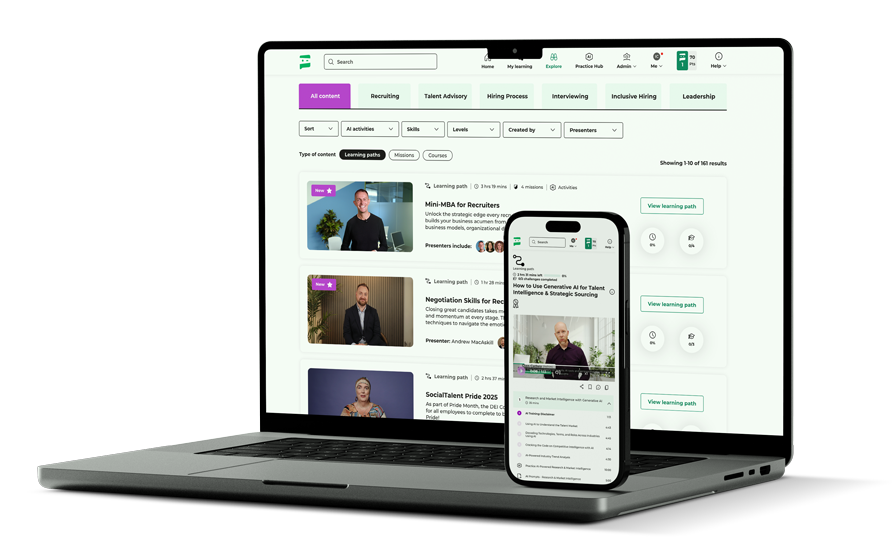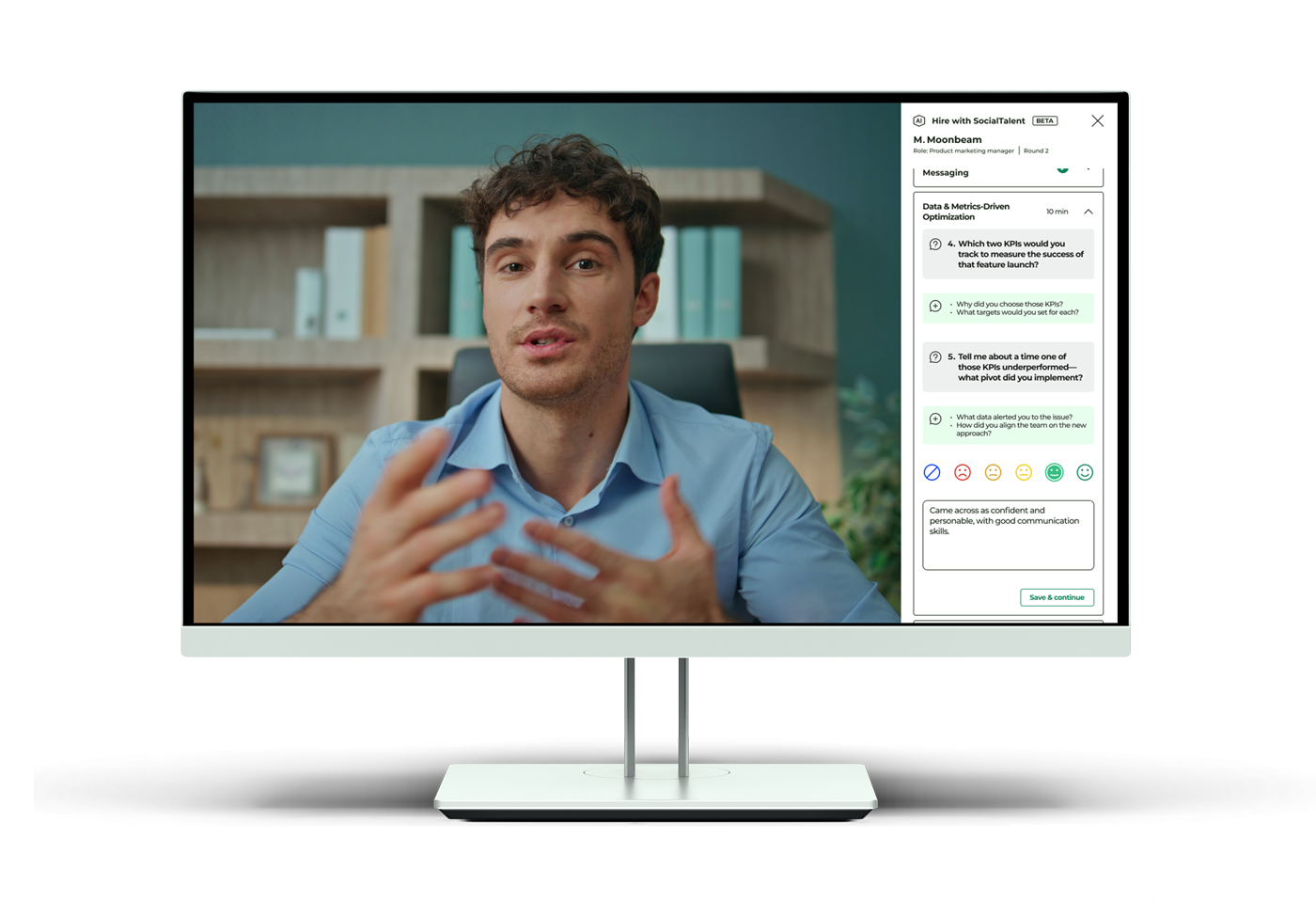Interview Training That Actually Works: Why Most Programs Fail and How to Fix Them
The goal of interview training isn’t to check a compliance box or fill seats in a conference room. It’s to build a cadre of skilled interviewers who can consistently attract, identify and close great talent for your organization.
This requires treating interview training like any other business-critical skill development: with clear objectives, proven methodologies, practical application, and meaningful measurement. When you optimize for competence instead of completion, you don’t just get better training – you get better hires.
Stop wasting money on training that doesn’t work. Start building the interviewing capability your organization actually needs.
The Problem
So you’re about to roll out an interviewer training programme? I’m glad I caught you, because I hope to save you months of wasted time and fast-track you on the lessons that other companies before you learned the hard way.
Here’s the scenario I see play out repeatedly: Your hiring manager completes your company’s mandatory interview training program. They pass the quiz, check all the boxes, and receive their certificate. Two weeks later, they’re in an interview asking a candidate, “Where do you see yourself in five years?” or “How many golf balls could fit in a 747?” and making hiring decisions based on gut feel.
Compare that to what excellence actually looks like: An interviewer asks structured, behavioral questions, gets an answer, then skillfully probes and pivots: “That’s great experience with large budgets. Can you give me an example of a project you delivered with significantly fewer resources?” They probe deeper, gather specific evidence, and make decisions based on relevant capabilities rather than assumptions. They dig into the real details, they’re engaged, and they come away confident of their hiring decision.
If you’ve ever wondered why your interview training investment hasn’t translated into better hiring outcomes, you’re not alone. After 15 years at SocialTalent and rolling out interviewer training to tens of thousands of hiring managers, I’ve heard the “before” horror stories and seen the same patterns repeat across organizations of every size: well-intentioned training programs that fail to create lasting behavior change.
The problem isn’t that people don’t want to interview better. It’s that most interview training programs are designed for compliance, not competence.
The Five Fatal Flaws of Corporate Interview Training
1. Optimizing for Completion, Not Competence
Before we even discuss content, there’s often a dead-stop obstacle: “It has to be under two hours because hiring managers won’t engage with anything longer.” This constraint reveals everything wrong with how organizations think about interviewing skills.
Would you accept a two-hour financial training program for someone managing million-dollar budgets? Would you limit sales training to an hour for people responsible for major client relationships? Yet somehow, we’re comfortable with minimal training for people making hiring decisions that could cost hundreds of thousands in turnover, poor performance, and opportunity cost.
This artificial time limit creates a checkbox mentality where success is measured by who finished the modules, passed the quiz, or attended the session – not who can actually conduct effective interviews. People find ways to game the system: playing e-learning videos in the background, guessing quiz answers, or mentally checking out during in-person learning sessions. There’s no verification that participants can apply what they’ve learned, no shadowing, role-playing, or practical skill demonstration required.
If your hiring managers won’t invest meaningful time in learning to interview well, you have a leadership and prioritization problem, not a training duration problem.
2. The Compliance-Only Mindset
Most HR and L&D teams approach interview training as a legal protection exercise. The focus becomes entirely about what not to ask rather than building the skills to conduct effective interviews. Hiring managers walk away knowing they can’t ask about family planning or age, but they have no framework for actually assessing job-relevant capabilities.
This results in interviewers who are paranoid about legal liability, but are completely unprepared to evaluate talent effectively. They default to safe, generic questions and make decisions based on “gut feel” because they were never taught how to systematically gather evidence of job-relevant skills.
3. The “Figure It Out Yourself” Approach
Many organizations offer interview training as an optional resource, assuming personal motivation alone will drive participation. Without clear business incentives, executive support, or connection to performance outcomes, these programs get ignored or deprioritized.
When interviewing skills aren’t treated as business-critical by leadership, they won’t be treated as important by hiring managers and interviewers either.
4. The Mediocrity Problem
We don’t know what we don’t know, and many of us just haven’t experienced excellence in interviewing to know what “excellent interviewing” we should be aspiring to. And so, when HR or L&D are tasked with a requirements list for training that’s essentially mediocre, they end up approving training content that sounds reasonable but lacks depth, nuance, or practical application. Experienced hiring managers can spot this mediocrity immediately.
Learners disengage quickly, thinking either “I already know this” or “This doesn’t seem like best practice.” Either way, they tune out.
5. The Information Dump Fallacy
Traditional in-person training sessions are expensive and inefficient, requiring everyone to be present for basic information transfer. Meanwhile, the most valuable parts of learning (peer discussion, practice, and collaborative problem-solving) get reduced down or squeezed out due to time constraints.
Organizations spend the most money and time on the least effective part of the learning process because they conflate physical presence with performance.
The Better Way: Building Competence, Not Just Completion
The solution isn’t to abandon interview training, it’s to redesign it using proven learning science principles and clear standards of excellence. Here’s the framework that actually works:
Define Excellence First
Before designing any training, be crystal clear about what great interviewing looks like. Excellence means:
- Systematic evidence gathering using skills demonstration and structured behavioral questions, with skillful follow-up
- Real-time adaptability when candidate responses don’t match company realities
- Objective assessment based on job-relevant capabilities, not impressions or assumptions
- Bias mitigation through consistent processes and calibrated evaluation criteria
This clarity transforms training from generic advice into targeted skill building towards a specific (high) standard.
Apply the 70/20/10 Learning Model
10% – Information Transfer: Deliver core concepts through self-paced, interactive e-learning modules. This handles the basics: legal guidelines, interview question frameworks, identifying hiring criteria. People can absorb this content when it works for their schedule, using a medium that is accessible.
20% – Peer Learning: Bring learners together in small groups to discuss real scenarios, share experiences, and learn from each other’s challenges. This is where the “aha” moments happen – when someone shares how they handled a difficult interview situation or adapted a technique to their specific role.
70% – Practical Application: The bulk of learning happens through practice with real consequences. This traditionally meant shadowing experienced interviewers, but new AI-powered tools are making this scalable in ways we never imagined. Modern learning platforms now offer AI-led practice activities that provide real-time, personalized feedback – like having an on-demand coach available 24/7. Learners can practice specific techniques, work through challenging scenarios, or even develop structured questions for roles they’re currently hiring for, all with immediate, tailored guidance.
Flip the Classroom
Stop using expensive group time for information that can be consumed individually. Instead:
- Before the session: Participants complete foundational learning modules at their own pace
- During the session: Focus on discussion, practice, problem-solving, and collaborative learning
- After the session: Set a program of shadowing and feedback. Provide ongoing support, resources, and opportunities for continued practice.
Verify Competence Through Demonstration
Replace completion metrics with competence demonstrations:
- Practice with AI-powered feedback systems that can simulate difficult interview scenarios and provide immediate coaching
- Shadow experienced interviewers and discuss observations
- Conduct practice interviews with colleagues or trained actors
- Demonstrate key skills in low-stakes situations before high-stakes interviews
- Receive ongoing support through interview intelligence tools that can provide real-time guidance during live interviews and post-interview performance analysis.
The game-changer here is technology that can scale the “expert shadower” experience. Instead of relying solely on busy senior team members to provide feedback, AI-powered interview intelligence can offer discreet, personalized coaching both during and after interviews, helping interviewers learn from every interaction while maintaining compliance and driving toward excellence.
Create Business-Focused Incentives
Make interview training a business priority by connecting it directly to real outcomes:
- Link to performance metrics: Connect interviewing skills to hiring success rates, time-to-fill, and quality of hire
- Executive sponsorship: Have leaders share why interviewing matters to business outcomes
- Peer advocacy: Create opportunities for trained interviewers to share success stories and recommendations
- Career development: Position strong interviewing skills as valuable for advancement with all employees.
The AI Revolution: Solving the Practice Problem at Scale
Here’s what’s particularly exciting about addressing interview training challenges right now: AI is finally making it possible to bridge the gap between passive content consumption and real-world application at scale.
The traditional bottleneck has always been the 70% – practical application. You can deliver information efficiently and create peer discussion opportunities, but how do you give every learner personalized feedback on their interviewing techniques? How do you let them practice difficult scenarios safely before they’re in front of real candidates?
Modern AI-powered learning platforms are solving this with on-demand practice activities that provide real-time, personalized feedback. Think of it as having a skilled interview coach available 24/7 who can:
- Guide learners through specific techniques like proper behavioral questioning and follow-up probing
- Simulate challenging scenarios such as getting an interview back on track when a candidate goes off-topic
- Help develop robust, structured questions tailored to roles learners are currently hiring for
- Provide immediate, personalized feedback on interviewing approach and effectiveness
This isn’t just theoretical practice – it’s applied learning that mirrors real interview situations but in a safe environment where mistakes become learning opportunities rather than hiring disasters.
The breakthrough is that learners can immediately apply what they’ve learned from the foundational content, get expert feedback, and iterate until they’ve mastered the technique – all before they ever sit across from a candidate.
Conclusion
The goal of interview training isn’t to check a compliance box or fill seats in a conference room. It’s to build a cadre of skilled interviewers who can consistently attract, identify and close great talent for your organization.
This requires treating interview training like any other business-critical skill development: with clear objectives, proven methodologies, practical application, and meaningful measurement. When you optimize for competence instead of completion, you don’t just get better training – you get better hires.
Stop wasting money on training that doesn’t work. Start building the interviewing capability your organization actually needs.



